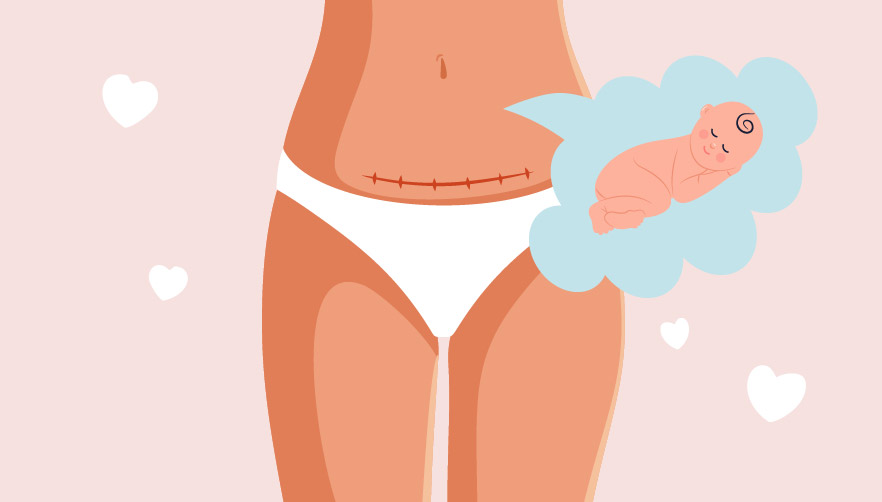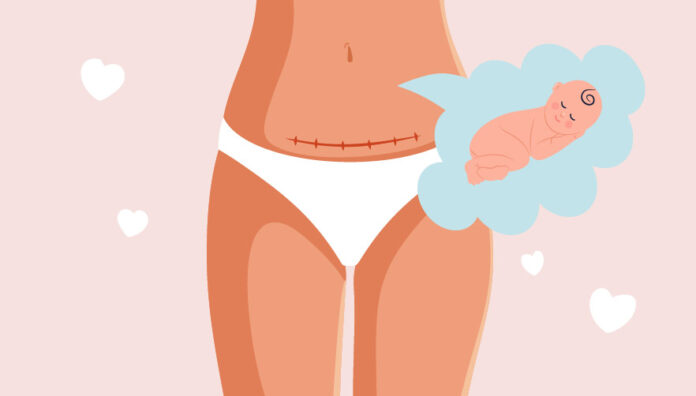A cesarean part, generally known as a c-section or ‘caesarean,’ is a surgical process the place the physician makes an incision within the mom’s belly and uterus partitions and delivers the child via the incision.
In keeping with the WHO, international C-section charges have elevated considerably from 7% in 1990 to 21% at present. There are various elements for this rise, from extra availability of life-saving well being procedures to an increase in girls electing to have the process because of age.
Regardless of how widespread this process is, there are nonetheless many misconceptions surrounding c-sections, their potential problems, whether or not they protect pelvic flooring well being higher than vaginal start, and the way they might have an effect on your toddler.
Why You (Or Your Physician) Could Select a C-Part
If there are issues stopping the child from being born via regular vaginal start, your physician could also be compelled to carry out a c-section. Your physician may focus on an elective (deliberate) c-section if there may be the potential that vaginal start is dangerous.
Whereas there may be the potential for electing for a c-section even for those who don’t face problems, most docs concur that vaginal start (when attainable) is the most secure manner to ship a baby. You, your companion, and your obstetrician ought to focus on your choices and select the most effective one for you.
Why You and Your Physician Could Plan a C-Part
Not all girls could also be required to have c-sections even when they fall below these circumstances, however widespread causes for deliberate c-sections embrace:
- You’ve beforehand had a c-section
- Your child is within the breech place (backside or ft first slightly than head first) and can’t be turned
- Your child is transverse (mendacity sideways) and unable to be turned
- The placenta is obstructing your cervix
- You’re birthing twins and the primary child is in a breech place
- You’re having three or extra infants
Why Your Physician Could Carry out an Unplanned C-Part
- Your contractions aren’t sturdy sufficient and your labor will not be progressing
- Your cervix is opening too slowly or in no way
- Your child’s head will not be shifting downwards or becoming via your pelvis
- The umbilical wire has prolapsed via the cervix and into the vagina after your waters have damaged
- Your child reveals indicators that their well being is being compromised
- A well being downside that makes labor riskier for you and your child resembling hypertension
Potential Dangers of A C-Part To The Mom
In most nations with trendy medical care, a c-section is a comparatively protected surgical process that’s carried out on a regular basis, however as with all main surgical procedures, it carries sure dangers for each you and the child. Some widespread dangers and problems through the process embrace:
- Blood clots within the legs
- Above-average blood loss
- An prolonged keep within the hospital
- The uterine lining changing into contaminated
- Points with having the ability to give vaginal start sooner or later
- Ache across the incision
- Anaesthetic-related problems
The Tightness Delusion
There’s a widespread false impression that delivering a child by way of c-section will assist retain vaginal tightness greater than vaginal start.
Whereas there may be proof suggesting that birthing by way of c-section has decrease dangers of pelvic organ prolapse and urinary incontinence than vaginal start, vaginal tightness is determined by pelvic flooring well being, and c-sections nonetheless impression pelvic flooring muscular tissues and general lower-body well being. For instance, girls who’ve c-sections usually tend to expertise ache throughout intercourse, in addition to of their genitals, decrease stomach, and urinary tract.
Our our bodies are going to be totally different postpartum it doesn’t matter what you do. Though the child doesn’t go via the vaginal canal throughout a c-section, the pelvic flooring muscular tissues, vulva, and vagina are nonetheless careworn.
Caesareans are a big surgical procedure that usually impacts pelvic flooring and core coordination and power. This implies that you could be nonetheless develop postpartum pelvic flooring dysfunction even for those who don’t give vaginal start.
You’ll have the next threat of creating postpartum pelvic flooring dysfunction if:
- You could have pre-existing pelvic flooring dysfunction
- You’re having the child at an older age
- Your BMI is increased than really useful at supply
- You’re delivering a bigger child
- You could have a household historical past of pelvic flooring issues
Some Childhood Circumstances Could Be Correlated To C-Sections
It’s necessary to notice that the potential dangers to your child throughout a C-section are literally far much less than throughout vaginal start. Nevertheless, there are some research exhibiting constructive correlations between sure well being circumstances and infants delivered by way of c-section.
A kind of is respiratory points, particularly if the c-section is carried out earlier than 39 weeks, as a result of the method of labor helps clear the child’s lungs of fluid. There seems to be a correlation between being born via c-section and the child creating bronchial asthma later in life.
Different well being circumstances which may be probably correlated with c-section supply embrace:
- Bronchial asthma
- Allergic rhinitis or conjunctivitis
- Atopic dermatitis or eczema
- Meals allergy symptoms
- Allergic sensitization in offspring
Once more, whether or not or not you have chose for a c-section or vaginal start is determined by your well being and private preferences. Your obstetrician ought to clarify every side of supply to you and information you to make knowledgeable selections about your well being.


